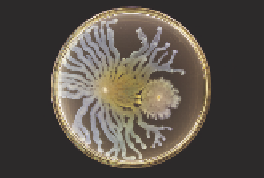Biology Reference
In-Depth Information
(a)
(b)
100
High relatedness
80
75
60
50
40
Low relatedness
25
20
0
0
0
1
2
3
4
56
Signal
negative
Signal
blind
Time
Fig. 14.16
Quorum sensing and relatedness in the bacterium
Pseudomonas aeruginosa
. (a) Quorum
sensing signal negative and signal blind cheats invade populations of wild type cooperators over 48 h of
growth. The mutants were distinguished from the wild type by labelling with a green fluorescent protein.
Light blue and dark blue bars represent the starting and final percentage of cheats in the population,
respectively (± s.e.m). (b) The proportion (± s.e.m.) of quorum sensing individuals (wild type) is plotted
against time (rounds of growth). Blue points represent relatively low relatedness and red points represent
relatively high relatedness. The experiment was started with an equal mixture of the wild type and signal
blind mutants that didn't respond to signal. High relatedness selects for quorum sensing, whereas low
relatedness allows mutants that do not respond to signal to be maintained in the population. From Diggle
et al
. (2007). Reprinted with permission from the Nature Publishing Group. Photograph shows a normal
quorum sensing colony (left) and a colony consisting of (signal blind) mutants that do not quorum sense
(right). Photo © Steve Diggle.
exoproducts to be switched on at high population densities. In contrast, when mutants
and the wild type were grown in a mixture, both types of mutant were able to increase
in frequency, showing that they can exploit the signalling or response to signal of the
wild type, without paying the cost (Fig. 14.16a). This showed that quorum sensing can
be exploited by individuals who do not signal honestly and, hence, that the problem of
honest signalling occurs.
Diggle
et al
. then tested whether the stability of quorum sensing can be explained
by a common interest that results from a high relatedness. To do this they initiated
populations with a mixture of wild type cells that quorum sensed, and signal blind
mutants that did not respond to signal. They then maintained the populations under
conditions that would lead to either a high or low average relatedness. They did this
by splitting the population into subpopulations and then initiating each
subpopulation, in each round of growth, with either a single bacterial clone
(relatively high relatedness) or with a 20
Individuals that
don't signal, or
don't respond to
signal, can invade
populations of
quorum sensing
cells
l sample that contained about 1.2 × 10
9
cells (lower relatedness). This experiment was, therefore, very similar in design to the
experiment described in Chapter 11, which tested how relatedness influenced the
cooperative production of iron scavenging siderophore molecules. As predicted by
Brown and Johnstone's model, the signal blind mutant was rapidly lost from the
μ
Quorum sensing
is favoured when
interacting cells
are more highly
related




















































































